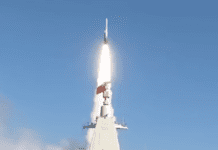This post is also available in:
 עברית (Hebrew)
עברית (Hebrew)
The increased use of drone technologies has led to a proliferation in the aerial vehicles’ military use. Drones are not only used for reconnaissance, intelligence or even bombing, but are now also designed as ‘suicide’ agents, which can revolutionize modern warfare.
In a move that echoes its first revolution in modern warfare, the Kalashnikov group has recently introduced the suicide drone.
The Kalashnikov drone — officially named the KUB-UAV — will likewise be simple to operate, effective and cheap, its manufacturers claim — and just as revolutionary.
The KUB is four feet wide, can fly for 30 minutes at a speed of 80 mph and carries six pounds of explosives, the news release says. The drone is compact in size and can be guided to explode on a target 40 miles away.
Despite the enthusiasm around this use of the technology, the suicide drones are not entirely new. The Islamic State pioneered the art of attaching explosives to commercially available drones and detonating them on advancing troops and enemy bases during the battles for the cities of Mosul and Raqqa in Iraq and Syria.
Russian troops in Syria were targeted by the biggest-ever suicide drone assault in Syria last year, when a swarm of more than a dozen crudely assembled devices incorporating explosives and GPS guidance systems descended onto Russia’s air base in Syria.
According to reports, the U.S. and Israeli militaries have incorporated suicide drones into their arsenals — but controls on the export of technology mean the devices aren’t shared outside a small circle of close allies, according to washingtonpost.com.
The Kalashnikov drone will be faster and more accurate, and will deliver twice the explosive charge and have a greater range than any of the crude homemade devices that have been patched together by terrorists.
Unlike the reported U.S. and Israeli exploding drones, the Russian one is promised to be relatively cheap.
The target market will be “smaller armies” around the world meaning the availability of the KUB will bypass controls imposed by the United States and its allies that are designed to keep weaponized drones out of the hands of their foes.
The potential for terrorists to use drone bombs to carry out attacks is one of the biggest worries surrounding the proliferation of the technology. Terrorists are more likely to continue to improvise their own ways of rigging explosive drones using cheaply available commercial devices and their own bombmaking expertise rather than spend on a ready-made version. But the spread of kamikaze drones will also intensify efforts to counter them, which will enhance existing capabilities.


























